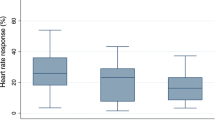Summary
Arbutamine, developed for use as a cardiac stress agent, was compared with isoproterenol and dobutamine in anesthetized dogs for cardiovascular actions prior to and after beta-adrenergic blockade with propranolol. The efficacy and safety of arbutamine were also evaluated in a canine model of myocardial ischemia obtained by partially occluding the left anterior descending coronary artery. Comparison of hemodynamic variables in normal dogs showed that arbutamine was approximately equipotent to isoproterenol in increasing heart rate and cardiac contractility, and in decreasing total peripheral vascular resistance and mean arterial blood pressure. Arbutamine was 210 times more potent than dobutamine in increasing cardiac contractility by 70%; however, at this dose dobutamine exhibited a negative chronotropic response. Beta-adrenergic blockade with propranolol shifted the agonist's dose-response curves for heart rate and contractility to the right; however, low doses of dobutamine exhibited a negative chronotropic effect and increased the total peripheral vascular resistance. In dogs subjected to partial left anterior descending coronary artery occlusion, arbutamine produced significant ST-segment deflections, beginning at a dose of 0.1 nmol/kg/min. Impairment of segment shortening, reflecting cardiac wall motion abnormality, was evident at a dose of 0.3 nmol/kg/min. Isoproterenol did not cause significant changes in these parameters. These results show that arbutamine is capable of producing graded increments in cardiac contractility and rate before and after betaadrenergic blockade in normal dogs. In dogs subjected to coronary artery occlusion, it is capable of provoking myocardial ischemia at dose levels devoid of toxicity.
Similar content being viewed by others
References
Borer JS, Brensine JF, Redwood DR, et al. Limitations of the electrocardiographic response to exercise in predicting coronary artery disease. N Engl J Med 1975;293:367–371.
Marangelli V, Iliceto S, Piccinni G, De Martino G, Sorgiente L, Rizzon P. Detection of coronary artery disease by digital stress echocardiography: Comparison of exercise, transesophageal atrial pacing and dipyridamole echocardiography. J Am Coll Cardiol 1994;24:117–124.
Manca C, Bianchi G, Effendy FN, Blognesi R, Cucchini F, Visioli O. Comparison of five different stress testing methods in the ECG diagnosis of coronary artery disease. Cardiology 1979;64:325–332.
Nagarajan R, Parthasarathy S, Makilhan S, Bala Subramanian V. Isoproterenol—an alternative to exercise testing. Indian Heart J 1989;21:99–104.
Wexler H, Kuity J, Simonson E. Electrocardiographic effects of isoprenaline in normal subjects and patients with coronary atherosclerosis. Br Heart J 1971;33:759–764.
Combs DT, Martin CM. Evaluation of isoproterenol as a method of stress testing. Am Heart J 1974;6:711–715.
Lockett M. Dangerous effects of isoprenaline in myocardial failure. Lancet 1965;2:104–106.
Johnson GL, Ehrrich SJ, El-Hage AN, Balazs T. Effects of antiarrhythmic agents on isoproterenol induced ventricular fibrillation in heavy rats: A possible model of sudden cardiac death. Res Commun Chem Pathol Pharmacol 1986;51: 351–364.
Tuttle RR, Mills J. Development of a new catecholamine to selectively increase cardiac contractility. Circ Res 1975;36: 185–196.
Baptista J, Arnese M, Roelandt JR, et al. Quantitative coronary angiography in the estimation of the functional significance of coronary stenosis: Correlations with dobutamine-atropine stress test. J Am Coll Cardiol 1994;23: 1434–1943.
Picano E, Diastante A, Masini M, Morales MA, Lattanzi F, L'Abbate A. Dipyridamole-Echocardiography test in effort angina pectoris. Am J Cardiol 1985;56:452–456.
Young M, Pan W, Wiesner J, et al. Characterization of arbutamine: A novel catecholamine stress agent for diagnosis of coronary artery disease. Drug Dev Res 1994;32:19–28.
Abou-Mohamed G, Nagarajan R, Ibrahim TM, Caldwell RW. Characterization of the adrenergic activity of arbutamine, a novel agent for pharmacological stress testing. Cardiovasc Drug Ther 1996;10:39–47.
Ruffolo RR, Spardlin TA, Pollock GD, Waddell JE, Murphy PF. Alpha and beta adrenergic effects of the stereoisomers of dobutamine. J Pharmacol Exp Ther 1981;219:447–452.
Caldwell RW, Nash CB, Smulkowski M, Tuttle RR. Cardiovascular effects of KM-13, a new orally effective cardiotonic sympathomimetic amine. J Cardiovasc Pharmacol 1987;9: 375–384.
Ruffolo RRJr. Review: The pharmacology of dobutamine. Am J Med Sci 1987;294:244–248.
Kenakin TP, Johnson SF. The importance of the alpha-adrenoceptor agonist activity of dobutamine to inotropic selectivity in anesthetized cat. Eur J Pharmacol 1985;111: 347–354.
Vatner SF, McRitchie RJ, Braunwald E. Effects of dobutamine on the left ventricular performance, coronary dynamics and distribution of cardiac output in conscious dogs. J Clin Invest 1974;53:1265–1273.
Bolter CP, Ledsome JR. Inotropic and chronotropic responses of the in vivo denervated dog myocardium to dobutamine. Can J Physiol Pharmacol 1976;54:618–621.
Sakanashi M, Tomamatsu E, Takeo S, et al. Effect of dobutamine on coronary circulation and cardiac metabolism of the dog. Drug Res 1978;28:798–801.
Abou-Mohamed G, Caldwell RW, Carrier GO, Elmazar MM, Tuttle RR. Interaction of a novel catecholamine, GP-128, with adrenergic receptors. J Cardiovasc Pharmacol 1994;23:492–500.
Kenakin TP. An in vitro quantitative analysis of the alpha adrenoceptor partial agonist activity of dobutamine and its relevance to inotropic selectivity. J Pharmacol Exp Ther 1981;216:210–219.
Ganong WF. Review of Medical Physiology, 16th ed. Norwalk, CT: Appleton and Lange, 1993, pp 574–575.
Author information
Authors and Affiliations
Rights and permissions
About this article
Cite this article
Nagarajan, R., Abou-Mohamed, G., Myers, T. et al. A novel catecholamine, arbutamine, for a pharmacological cardiac stress agent. Cardiovasc Drug Ther 10, 31–38 (1996). https://doi.org/10.1007/BF00051128
Received:
Accepted:
Issue Date:
DOI: https://doi.org/10.1007/BF00051128




